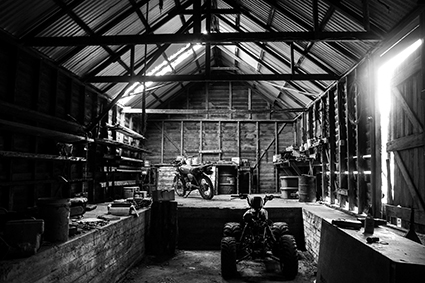When buildings sing
Judith Abell: Tasmanian International Arts Festival: Acoustic Life Of Sheds

Jack’s Shed, Acoustic Life of Sheds, Tasmanian International Arts Festival
photo Lisa Garland
Jack’s Shed, Acoustic Life of Sheds, Tasmanian International Arts Festival
Circling the milling crowd on a far flung Tasmanian farm is a series of hand built electronic harps amplifying the sound of wind on the strings and creating an intriguing late-afternoon atmosphere. As we are let into the somewhat prosaic tin shed we’re greeted by an unexpected wall of smoke. Three formally dressed players emerge from it on the raised shearing floor and the composition begins with the breathy, loose sounds of Phil Slater on trumpet accompanied by unearthly contrabass recorder played by Genevieve Lacey, its low, fluttering emanation sitting somewhere between whale song and the growl of a beast. Gradually, harpist Marshall McGuire joins the mix. We are participating in Acoustic Life of Sheds.
Part of the Tasmanian International Arts Festival, the production involves established and emerging composers, improvisers, instrumentalists and visual artists working in five sheds across the North West Coast of Tasmania, between Wynyard and Stanley. The project had a long lead-in, with commissioned artists building a visual and harmonic familiarity with selected sites throughout the year prior. In each case, there is a sense that the spirit of the shed, its key protagonists, or the nature of sheds per se, has crept into the work.
We start our journey at a quirky shed on the coast east of Wynyard. Comprising a built collage of ex-prison block and a series of workers huts, this is Bruce’s Shed. The amateur museologist brought these buildings together in order to display his curious collection of items reflecting local history, zoology and his own life. For his live, sonic installation composer Damien Barbeler’s inspiration has sprung from Bruce’s childlike sense of adventure and curiosity, placing players and digital mixing equipment like exhibits within side rooms, while we stand clustered within the central, stone-flagged corridor. Initially in darkness, we are sporadically lit via a ceiling of white balloons that conceal a lighting system linked to the work’s ebbs and flows. The composition uses the instruments to make sampled textural sounds, originating from plucking or scraping on strings, layered against longer bowed notes. “It doesn’t sound like music,” says a young audience member.
The third shed is part of a tiny village of buildings spanning the Table Cape road. Here we meet Jack Archer via his recorded voice, his sheepdog whistles, his sheds, his objects. He is also present as a portrait, taken by local artist Lisa Garland; printed onto thin fabric it ripples in the breeze as Jack ‘overlooks’ performers Madeleine Flynn and Tim Humphrey. The pair, using sampled and live sounds from a ruined piano and a flugelhorn are literally playing in this mechanics shed. They work their way through a series of short pieces that take their lead from Jack’s reputation as a sheep dog trainer. They tinker with sound, mess with the piano’s tuning and speak casually to the audience of their process.
The day-long experience concludes with a three-piece ensemble led by renowned recorder player Genevieve Lacey. She asked the family of Blackridge Farm to keep handheld sound recorders with them over a number of weeks so she could use the recordings to imbibe the life of the farm from a distance: “we eavesdropped on feed runs, overheard quiet, meandering chats and shared jokes, gates and tractors, shearing sessions, pigs being born, birds by the creek”.
The work is in two parts, the first, outside, is provided by an Aeolian harp-fence. The second, by Lacey, for trumpet and harp, brings the shed into the work by wiring it with surface exciters such that every vibration becomes a sound layer. The composition is a contemplative, atmospheric improvisation on the sound diary, full of long, wavering notes that feel in equal part of this place and out of place. Tiny local noises find their way into the work, such as a bird that Lacey memorably mimics with her tiny sopranino recorder.
Acoustic Life of Sheds was a compelling and enjoyable journey of discovery within spaces that usually remain the domain of their owners. The calibre of performers cast for each site made for unique experiences that ranged from the congruent, such as Lucky Oceans improvising country riffs on pedal steel in the filtered light of a shearing shed, to the incongruent—Lacey losing herself in a contrabass recorder. The most successful moments were those where the performers really engaged with the ad hoc spirit of tinkering and ingenuity that is inextricably linked to the Australian shed.
Weeks after the performances and country driving, I still find myself wondering about sheds I pass—what artefacts sit exposed, what they sound like, what the quality of light is from inside the smeary glass?
Tasmanian International Festival of Arts, Big hART Inc; Big hART, Creative Director Scott Rankin, Creative Producer Andrew Viney; Tasmania, 21, 22, 28, 29 March
RealTime issue #127 June-July 2015 pg. 28






